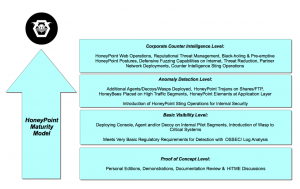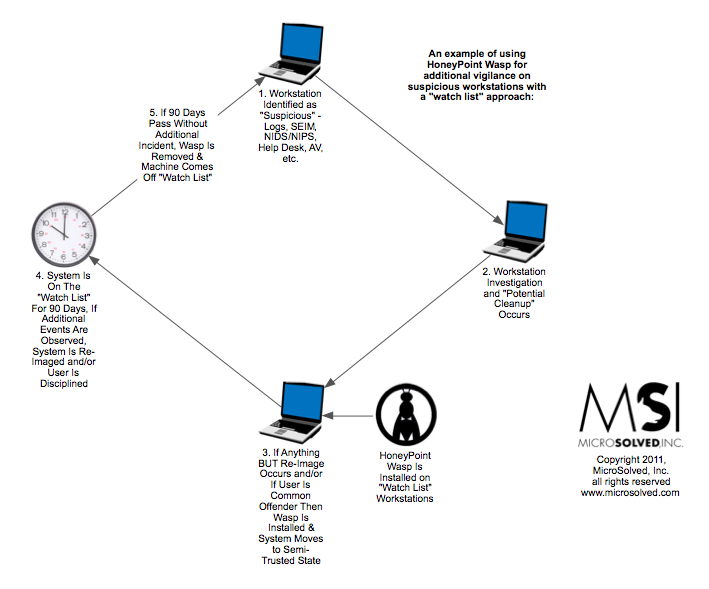Category Archives: HoneyPoint
Quick Use Case for HoneyPoint Wasp
Several organizations have begun to deploy HoneyPoint Wasp as a support tool for malware “cleanup” and as a component of monitoring specific workstations and servers for suspicious activity. In many cases, where the help desk prefers “cleanup” to turn and burn/re-image approaches, this may help reduce risk and overall threat exposures by reducing the impact of compromised machines flowing back into normal use.
Here is a quick diagram that explains how the process is being used. (Click here for the PDF.)
If you would like to discuss this approach in more detail, feel free to give us a call to arrange a one on one session with an engineer. There are many ways that organizations are leveraging HoneyPoint technology as a platform for nuance detection. Most of them increase the effectiveness of the information security program and even reduce the resources needed to manage infosec across the enterprise!
MicroSolved’s HoneyPoint Wasp Nominated for TechColumbus Innovation Award
 MSI is proud to announce their nomination in the annual Innovation Awards, sponsored by TechColumbus, which recognizes outstanding achievements in technology leadership and innovation. HoneyPoint Wasp has been nominated for Outstanding Product for companies with 250 employees or less.
MSI is proud to announce their nomination in the annual Innovation Awards, sponsored by TechColumbus, which recognizes outstanding achievements in technology leadership and innovation. HoneyPoint Wasp has been nominated for Outstanding Product for companies with 250 employees or less.
We’re thrilled to be nominated. We believe our HoneyPoint Wasp is an excellent product, helping our clients battle bots and malware on their desktops. For more information, please read our press release and visit our HoneyPoint webpage. We look forward to the Awards Dinner in February 2012. Good luck to everyone who has been nominated!
HoneyPoint Maturity Model
 Many folks have asked for a quick review of the way HoneyPoint users progress as they grow their confidence in the product suite and in their capability to manage threat data. To help answer those questions and to give folks a quick way to check out how some folks use HoneyPoint beyond simple scan/probe detection, we put together this quick maturity model to act as a roadmap.
Many folks have asked for a quick review of the way HoneyPoint users progress as they grow their confidence in the product suite and in their capability to manage threat data. To help answer those questions and to give folks a quick way to check out how some folks use HoneyPoint beyond simple scan/probe detection, we put together this quick maturity model to act as a roadmap.MicroSolved Releases HoneyPoint Special Edition: Morto
 We are pleased to announce the immediate availability of a special edition of HoneyPoint that is designed to help organizations identify hosts infected with the Morto worm that is currently circulating.
We are pleased to announce the immediate availability of a special edition of HoneyPoint that is designed to help organizations identify hosts infected with the Morto worm that is currently circulating.
HPMorto works like this: It opens a TCP listener HoneyPoint on port 3389/TCP (check to make sure that port is NOT in use before running HPMorto). Once in place, the tool will report the source IP of any systems who attempt to connect to it. Identified sources should be investigated as possible infected hosts.
This version will only listen for 3389 connections and will only function through February 28, 2012.
Versions of HPMorto are available for FREE download for:
Windows
Linux
Mac OSX
Give it a try and we hope that this tool help folks manage the problems being caused by Morto around the world.
Audio Blog: Brent Huston – HoneyPoint Security Server Manifesto Part Two
We continue our interview with Brent Huston as he answers a few questions about HoneyPoint Security Server, and HoneyPoint Agents.
In this installment, you’ll learn:
- What HoneyPoint Agent is and its role in the suite
- How information techs are using HoneyPoint
- How can people use Agent with DNS and blacklisting, and why it’s significant
- What HoneyPoint Decoy is and how it is utilized in an environment
- The three different “flavors” of HoneyPoint Decoy
MSI HoneyPoint Featured on Virtualization Security Podcast

Brent Huston, CEO and Security Evangelist of MicroSolved, Inc., was recently a guest for the popular podcast, “Virtualization Security Podcast.”
Brent talked about HoneyPoint Wasp and discussed with other panelists how honeypot technology can help an organization detect real attacks and also the legal ramifications of stealth monitoring.
The Virtualization Practice also featured HoneyPoint in their recent post, “New Virtualization Security Products Available.”
The podcast panelists include;
- Edward L. Haletky, Author of VMware vSphere and Virtual Infrastructure Security: Securing the Virtual Environment and virtualization security analyst, as Moderator.
- Michael Berman, CTO of Catbird Security
- Iben Rodriguez, Independent Virtualization and Security Consultant and Maintainer of the ESX Hardening Guidance from CISecurity
Click on the player below to listen. To listen on iTunes or download the MP3, go here. Enjoy!
Horrible Ideas, Modeled & Profiled
Just a quick note this time about the HITME (HoneyPoint Internet Threat Monitoring Environment). One of the best uses for having the kind of global honeynet that we have deployed in the incarnation of the software is that you can create actual working models for a mistake or a horrible security idea.
Want to know what happens if you accidentally expose an internal system to the public Internet for 24 hours? We can quickly (in less than 30 mins) build an emulation for it and use a decoy dropped into place on your network to measure and model that risk over a period of time. You can get a real life set of metrics for how many probes it receives, from where and for what the attackers are looking. You can find out how long the average time is before the issue is identified by an attacker. You can even work up a profile of what sources, their locale and their capability to add to your risk assessments. These kinds of metrics, tied to a strong mathematical model (like FAIR) make for fantastic real world analysis.
You can do the same with web applications. Want to know what kind of attacks you can expect if you put in a new VPN portal at your managed hosting provider? No problem. We create an emulation and drop a decoy into their ESX(i) infrastrcuture, monitor it for 30 days and work up the data into a report for you. Now you can take that data and feed into a risk assessment, work out compensating controls and even get a budget idea for what it will take to secure such an infrastructure. We can also do this in multiple places and then work with the reporting you get from several vendors, using this mock up as a bake off data point to help you determine if your exposures and risks are higher from one hosting provider to another, what kinds of reporting you get from each, how effective their prevention and detection programs are, etc. We’ve even had a couple of organizations drop in temporary HoneyPoint decoys while being audited or undergoing penetration testing to get a third party view of how effective and capable their assessment and testing process has been.
The coolest thing to me about HoneyPoint is not the bleeding-edge attacks you can capture, nor the insights into attacker behavior it brings. Instead it’s the wide array of business problems that it can lend real world insight to inside the security world. It truly makes it easy to model and measure some of the most horrible ideas that an admin or developer can have. Wanna know more about the mistakes you make or might make in the future? Wanna measure attack interactions or generate metrics to feed a better risk assessment? Give us a call, we’ll be glad to discuss how you can take the next step in threat-centric information security with HoneyPoint!
From the Tweetstream: What HITME Caught: Ongoing Defacement Campaign
Recently, we noticed our @HoneyPoint account, (HoneyPoint Internet Threat Monitoring Environment or HITME) was getting pinged. What we found is explained below:
[blackbirdpie url=”http://twitter.com/#!/lbhuston/status/67954775886544896″]
[blackbirdpie url=”http://twitter.com/#!/lbhuston/status/67955056300920832″]
[blackbirdpie url=”http://twitter.com/#!/lbhuston/status/67955546187243520″]
[blackbirdpie url=”http://twitter.com/#!/lbhuston/status/67973785218859008″]
[blackbirdpie url=”http://twitter.com/#!/lbhuston/status/67974149250879489″]
[blackbirdpie url=”http://twitter.com/#!/lbhuston/status/67984136337498113″]
[blackbirdpie url=”http://twitter.com/#!/lbhuston/status/67985250583715840″]
[blackbirdpie url=”http://twitter.com/#!/lbhuston/status/67985707125325824″]
[blackbirdpie url=”http://twitter.com/#!/lbhuston/status/67990169353068544″]
Tales from the Tweetstream: Are You Trusting AV Software Alone to Detect Malware?
(To read more interesting discoveries, follow Brent Huston on Twitter.)
[blackbirdpie url=”http://twitter.com/#!/lbhuston/status/61498319142260737″]
[blackbirdpie url=”http://twitter.com/#!/lbhuston/status/61499509645127680″]
[blackbirdpie url=”http://twitter.com/#!/lbhuston/status/61499751950069760″]
[blackbirdpie url=”http://twitter.com/#!/lbhuston/status/61513076557615104″]
AV software is not a “deploy and forget” solution to detect malware. More surveillance is needed, such as checking the logs to see if there are any occurrences of strange activity. Too often, attackers can drop files in the PHP servers and AV software will rarely detect it.
As I said, the moral of the story is that if you’re depending upon an AV detection mechanism for compromised PHP servers, you’re mistaken. Protect your servers by analyzing your logs. And using our HoneyPoint Wasp would help greatly by giving you more visibility and alerts when malware has entered into your system.


